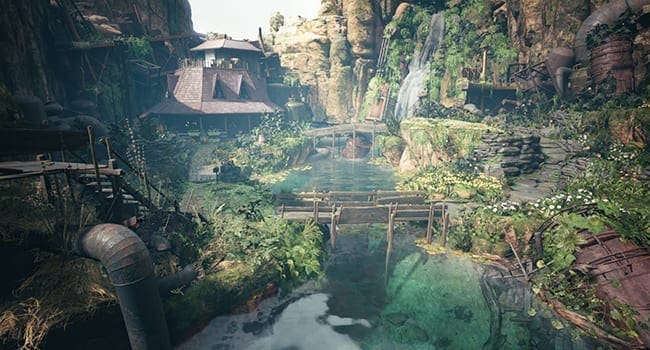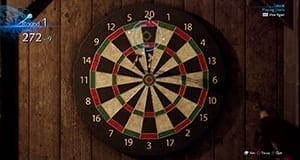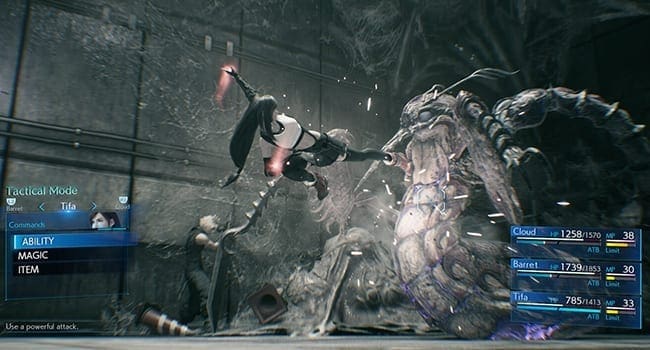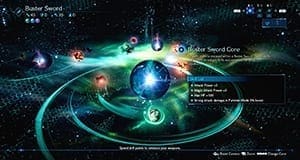
This is Aerith’s house, one of the most visually stunning locations in all of FFVII Remake
Final Fantasy VII Remake
Developer/Publisher: Square-Enix
Platform: PlayStation 4

It was a beautiful moment when Final Fantasy VII Remake ceased to be a remake and became a game of its own.
It hit me as the game took me to my first visit to the slums of Sector 7. I looked around thinking this was one of the most lively and full representations of community in a game that I had ever seen.
I looked at the people gossiping, waiting in line for coffee, humming wordlessly to themselves while painting. And then I looked up at the massive metal and concrete plate in the sky that supports the upper city and the people who live on it – a representation of segregation between wealthy and poor.
I’d always wondered what that looked like when I played the original Final Fantasy VII as a kid but I could only imagine. Seeing it in the remake was awe-inspiring and it filled me with dread. The view somehow affirmed my hopes for this game. It’s vast and intimidating but promises a full, fleshed-out world waiting to be discovered.
I felt like that view was the developers saying: “Yes, we know what you want. Because we’ve wanted it, too.”
By the time I saw that view, I’d already had a taste of the gameplay and story, and felt confident I was in for a good game. But that first look skyward upped the expectation.
FFVII Remake is an exploration, deep dive and evolution of everything in the original Final Fantasy VII: combat, story, world, characters and materia (magic).
On the off chance anyone who’s gone out of their way to read this doesn’t already know, FFVII Remake is an action-RPG, rather than a classic Japanese RPG like the original. So action is fast-

A mini-game where Cloud plays darts in a bar. I didn’t get much for winning but it was fun anyway!
paced yet tactical, requiring focus and deliberate decisions, including when facing the basic scrubs.
Each character plays differently in combat, which is something the original didn’t really allow for.
In the version from the 1990s, your characters could mostly only be customized through the materia you allocated to them. Now, since combat is more free-flowing and you can control individual characters, you get to experience each one of their styles – and they all feel distinct. This shift gives the cast more personality.
Combat rock
The combat is a great deal of fun and never boring. And I don’t just mean the boss battles – the battles with soldiers, drones and beasts along the way are also entertaining. Most feel like a real threat – and could indeed be if you simply keep mashing away on the attack button.
Each group you encounter is a different compilation of enemies, so you always have to think of the mix of tactics you need to take them down.
Aside from the challenge and fun of the fights themselves, I began to see that each encounter was an opportunity to level up a materia, earn a new weapon ability or try out a new strategy. This created a satisfying continual reward system. You regularly get something or learn something new.
Just because I had become ‘proficient’ in an ability (weapons each have a unique ability and proficiency means you can use it with any other weapon) didn’t mean I really knew the best instances to use each.
Battle provides an opportunity to see how to best use a particular ability and, even though that’s not a tangible reward, it’s still satisfying when you learn to effectively execute a move.
That being said, I was able to get through the game – until the latter parts – without thinking too hard about which ability to use when. Focus was definitely required in combat but rarely was I ever wiped out.
Now that I’ve completed the game and unlocked a Hard difficulty, enemies are all beefed up and I can no longer use some items. I’m excited to see how this might push me to master the combat mechanics.
Each weapon has an upgrade system. It’s hard to say which weapon is best – they’re just different. Some are better for certain scenarios or in different party compositions, but you may find yourself changing your equipment frequently.

Tifa, a martial artist and bruiser, battling a huge insectoid creature. The combat was fun and fast, yet tactical. I never got bored of it.
Living in the materia world
Weapons are only one part of the equation, though. Materia is the other major part of combat.
The magic in FFVII Remake covers all the bases you’d expect: attacks, healing, protection and status effects. Some materia is supportive, some increase a stat, some magnify the abilities of your magic attack and one sets up your ally to do a certain action after you’ve done yours. There’s even a type of materia that gives you new attacking or healing abilities, which means you don’t have to use your precious magic points to make certain moves.
The weapons, their abilities and upgrade system, and the huge selection of materia provide you with the tools to build around a great variety of play styles.
Bricks in the Wall (Market)
The world of FFVII Remake is gorgeously detailed and full. It looks great right from the start and gets better as you move along.
There were a few spots where I just wanted to stay a while. I had nothing to do there, no objective. I just wanted to hang out and take in the scenery, the way you might when visiting somewhere truly breathtaking in real life. Aerith’s house, Wall Market and the Shinra building are all standouts (though the Shinra building is awe-inspiring in an oppressive, evil fortress kind of way).
Wall Market takes the cake when it comes to being vibrant and bustling. It’s here you experience the wild, flashy, seedy nightlife of lower Midgar. And you need to navigate the dark criminal underworld to reach your goal.
The other two town-type locations in FFVII Remake, the Sectors 7 and Sector 5 slums, are full of good characters and stories, and some interesting surrounding locales. But Wall Market (Sector 6) is something else. The lights and signs, the restaurants and food stalls all reminded me of the vibrant streets of Tokyo or Osaka. I challenged someone to a squats competition, I had a little fun with gender and I danced my little heart out.
Anyone who has played the original knows Wall Market could have been a minefield in a modern re-imagining. The original had cross-dressing, sex, a fumbled interpretation of queerness and the suggestion of sexual assault. It was all done in such a goofy, cartoon-like manner that it did a disservice to the themes it tried to approach.
But I’d heard rumblings that Sector 6 was one of the best parts of the remake so I went into Wall Market excited, if apprehensive.
What I encountered was better than I could have hoped for.
The cross-dressing sequence was fun and lighthearted, without being mean-spirited or poking fun at anyone. One queer character in particular is brilliant, but I won’t spoil the surprise.
However, his existence in Wall Market points to the troubling Heteronormativity of the rest of the game. It’s the only location in the game where a character like this can exist, apparently, and it happens to be the most fabulous, garish location.
I don’t say this to take away from the character though. He was fantastic and fun and I very much hope there’s a way to see him in later games.
I’m still waiting for games where the queer characters just are and don’t feel like a set piece. I’ll be interested to hear what the LGBTQ community thinks about how Sector 6 was handled. I’m sure it will spark a lot of conversation.
The primary villain of Wall Market, Don Corneo, is still a cartoonish buffoon on the surface but the developers do a good job of depicting how incredibly twisted, disgusting and violent he is at his core.
With Wall Market, the developers carefully pulled back on or evolved the parts they should, and were smart enough to double down on others.
Flesh and blood characters
The main cast of characters, Tifa, Aerith, Barret and Cloud, all receive modern – and successful – fleshing out. I even liked surly old Cloud by the end of it. He finally starts being a little less macho and a little more of a real person, a step that took most of the original game, if I remember correctly (keeping in mind that the end of Remake brings us to maybe the 10 per cent mark of the original game).
Hopefully, we’ll see more significant growth in these characters down the road, especially Barret. He was the only one I didn’t like much. He comes across as a bad black-exploitation stereotype. He shows some development and his relationships change, but the voice, demeanour and aggression are unfortunate, especially in a game that doesn’t otherwise have a lot of black representation.
And in the end
To avoid spoilers I won’t go too deep into the story of FFVII, but suffice to say it goes to some surprising places.
The main story line is mostly what you would expect if you played the original.
But some crucial points are altered, changing the narrative, and there’s one huge element that differs from the original and has some vast implications for the world and ongoing story. This element serves as a sort of meta-narrative that compares the remake to the first game. It’s something you should discover for yourself.

The weapon upgrade system in FFVII Remake. Select a weapon to upgrade and it zooms in to this solar system-style layout where each of the orbs surrounding the core is a unique skill for said weapon
FFVII Remake digs deeper into the class struggle in Midgar and the effects of the bombings on the citizens. It’s a much more mature look at this city and the tragedies its people have had to endure – by your hand sometimes.
If you’re going to play this game, play to the end. Things get absolutely wild. There’s a crazy escalation of anime-style nonsense and it’s glorious. For a game with some dark themes, FFVII Remake can sure have a lot of fun with itself.
My gripes with the game are few and very far between.
I experienced one game-breaking bug while crawling through vents late in game, but other than some occasional texture popping, I didn’t notice any other technical goofs.
The few negatives don’t hold a candle to the blazing inferno of goodness that is Final Fantasy VII Remake. The developers managed to tap into nostalgia while creating a beautiful, modern, complex beast of their own.
It felt like they took forever to make this game and I’m sure glad they did. Against all odds and expectations, they managed to build a remake the original deserved.
This is the best Final Fantasy game produced in years.
Sam Stewart has a diploma in theatre studies, a degree in film studies and has worked professionally in both areas. He also worked in the tech industry and loves to indulge his lifelong passion for video games, from the classics to new releases.
The views, opinions and positions expressed by columnists and contributors are the author’s alone. They do not inherently or expressly reflect the views, opinions and/or positions of our publication.
